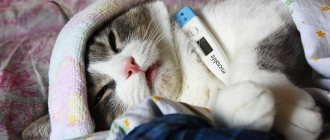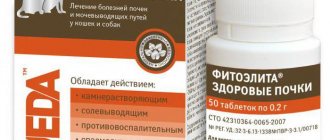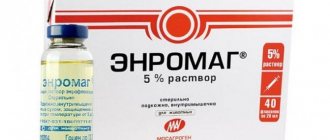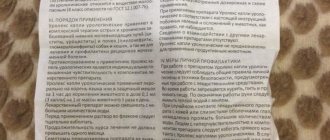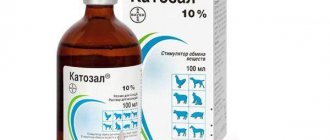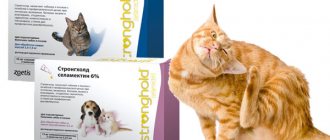Release form, composition and properties
The drug is supplied to pharmacies in the form of an emulsion for external use. The medicine contains an active substance called enilconazole. Additional components are polysorbate 20 and sorbitan laurate. The emulsion is placed in a glass bottle with a volume of 100 ml. With the help of medication it is possible to cope with almost all fungi. However, the most effective results are observed in the fight against Trichophyton verrucosum and Trichophyton mentagrophytes.
Once in the cat’s body, the active component helps destroy fungal cells. If the pet owner strictly follows the dose prescribed by the veterinarian, Imaverol will not harm the cat. According to the official instructions for use, the medication is classified as hazard class four. This indicates that it is low-risk. The medicine can be used not only for representatives of the cat family, but also for horses and dogs. The pharmaceutical product is not suitable for people.
Imaverol
for the treatment of dermatophytoses in cattle, horses, dogs and cats
(Developer organization: Eli Lilly and Company, ELANCO, USA)
I. General information
Trade name of the drug: Imaverol.
International nonproprietary name: enilconazole.
Dosage form: emulsion for external use.
Imaverol in 1 ml contains enilconazole as an active ingredient - 100 mg, as well as excipients: polysorbate 20 - 486 mg and sorbitan laurate - 486 mg.
In appearance, the drug is a transparent liquid with a thick yellow-brown consistency; when diluted with water, it forms a stable emulsion.
Imaverol is produced packaged in 100 and 1000 ml in glass or polymer bottles, sealed with caps. Each bottle is placed in a cardboard box and supplied with instructions for use.
Imaverol is stored in the manufacturer's sealed packaging, in a dry place, protected from light, separately from food and feed, at a temperature of 0 °C to 25 °C.
The shelf life of Imaverol, subject to storage conditions in the manufacturer's closed packaging, is 3 years from the date of production, after opening the bottle - 3 months. The medicinal product must not be used after the expiration date.
Imaverol should be stored out of the reach of children.
Unused medicinal product is disposed of in accordance with legal requirements.
II. Pharmacological properties
Imaverol belongs to the group of antifungal drugs for external use.
Enilconazole, which is part of the drug, is a synthetic antimycotic agent active against various types of fungi, including Trichophyton verrucosum, Trichophyton mentagrophytes, Trichophyton enuinum, Microsporum canis and Microsporum cjypseum.
The mechanism of action of enilconazole is based on the process of selective inhibition of the biosynthesis of ergosterol, the main component of the cell membrane of fungi and yeast, which leads to irreversible changes in their cell walls.
With local external use of the drug, enilconazole, having low systemic availability, is poorly absorbed through the skin and penetrates the body tissues in small quantities. It is excreted from the body of animals mainly through urine and feces; the half-life is 12-16 hours.
In terms of the degree of impact on the body, Imaverol is classified as a low-hazard substance (hazard class 4 according to GOST 12.1.007-76), in recommended doses it does not have a local irritant or resorptive toxic effect, and does not have teratogenic, embryotoxic, mutagenic or carcinogenic properties. The drug is well tolerated by cattle, horses, dogs and cats, and is toxic to aquatic organisms.
III. Application procedure
Imaverol is prescribed for the treatment of dermatophytoses (trichophytia, microsporia) in cattle, horses, dogs and cats.
Contraindication for use is the animal's hypersensitivity to the components of the drug.
Treatment of the animal is carried out using 0.2% medicinal emulsion of the drug, for the preparation of which Imaverol is diluted with warm water in a ratio of 1:50. The prepared medicinal emulsion of the drug should be used within 24 hours.
The animal is treated with a course of four treatments with an interval of 3-4 days.
In severe cases of the disease, after consultation with a veterinarian, the course of treatment can be extended.
In cattle and horses, the affected areas of the body along with the border areas of healthy skin are treated with a medicinal emulsion. Due to the presence of dermatophytes in hair follicles, all crusts on the animal’s body should be removed with a stiff brush moistened with Imaverol medicinal emulsion.
Dogs and cats are treated against the direction of hair growth, completely covering the affected areas of the skin with a medicinal emulsion; It is recommended to pre-cut animals of long-haired breeds. Small breed dogs and cats can also be treated by immersion in a container with a medicinal emulsion.
No symptoms of drug overdose were identified.
The specific effects of the drug upon its first use and withdrawal have not been established.
Violations of the drug use regimen should be avoided, as this may lead to a decrease in its effectiveness. If the next treatment is missed, it should be carried out as soon as possible in the same dose.
As a rule, there are no side effects or complications when using Imaverol in accordance with these instructions. If the animal has increased individual sensitivity to the components of the drug and allergic reactions occur, its use is stopped and, if necessary, the animal is prescribed antihistamines and symptomatic therapy.
Imaverol should not be used in animals in combination with other antifungal drugs for external use.
Slaughter of cattle and horses for meat is permitted no earlier than 4 days after the last use of Imaverol. In case of forced slaughter of animals before the established deadline, the meat can be used as feed for fur-bearing animals.
Milk from dairy animals can be used for food purposes no earlier than 48 hours (4 milkings) after the last use of Imaverol. Milk obtained earlier than the established deadline can be used as animal feed after heat treatment.
IV. Personal prevention measures
When working with Imaverol, you should follow the general rules of personal hygiene and safety precautions provided for when working with medicines.
When is the medication prescribed?
The drug can be used for zoophilic fungal infections in furry animals.
In veterinary practice, “Imaverol” is used to treat fungal infections of the body, which are usually divided into 3 types:
- zoophilic fungal infection;
- geophilic;
- anthropophilic.
Pets are often diagnosed with zoophilic spores. Based on the stage of development of the disease they are at, harm can be caused not only to the cat, but also to the owner. That is why it is important for a pet owner to systematically examine their pet. If red spots and peeling are noticed on the skin, you need to show the animal to a veterinarian who will conduct a diagnosis, which will help avoid complications.
Imaverol for cats: what is it for, when is it indicated
When kittens, children, old people and elderly cats come into contact with the skin, fungal spores begin to germinate. A fungal mycelium is formed, which feeds and grows, capturing new areas of damage. Micromycetes are activated as secondary microflora during viral infections. The likelihood of fungal infection increases when the body weakens with prolonged use of antibiotics, corticosteroids, and non-steroidal anti-inflammatory drugs.
Diagnosis of mycoses using a Wood's lamp
Ringworm is characterized by the appearance of patches of baldness, as well as thinning hairs. As a result, the hairs break off and look as if the cat had been cut. The virulence of the fungus increases, and a sick pet can infect other animals and humans.
Treatment with external ointments is long-term, and tableted antimycotics have side effects. Therefore, a chemotherapy drug is needed that can cure the disease in a short time without harming the cat’s health and prevent the spread of infection. Imaverol, which is a concentrate for preparing an antifungal emulsion, has these properties.
Be sure to read:
Why and how to inject Farmazin for cats: instructions and dosage 50-200
Instructions for use
To prepare the emulsion for use, you will need to dilute the medicine with boiled water at room temperature in a ratio of 1:50. The prepared product can be used within 12 hours. Before applying the medication, you need to treat the skin affected by the fungus with iodine. Anti-fur medication is applied. If your cat has long hair, you will need to trim the affected areas before treating the skin.
A hard brush is suitable for removing the keratinized layer of the pet's dermis, which contains many fungal spores.
To cope with a fungal infection in a cat, the skin must be treated 4 times. Between using Imaverol you will need to take a break of 4 days. In advanced situations, the doctor extends the course of therapy after examining and examining the pet. Since fungal spores are localized at the base of the coat, the owner will need to get rid of dead skin. For these purposes, it is recommended to use a stiff brush, which must be moistened in the prepared Imaverol solution.
Imaverol saved our kitten from lichen
We found our Tishka on the street, or he found us, it depends on how you look.
The kitten was very friendly, but looked unhealthy, especially with bald spots on his ear and face. They bathed him, fed him and took him to the veterinary clinic for vaccinations. The doctor said first we need to remove the worms and cure the lichen, the baby’s immune system is already weakened. And he also scolded us, it turns out that you can’t bathe people with lichen, we did it out of ignorance.
The fact that the ear was affected was visible to the naked eye. But a scan with a lamp showed that the poor fellow had lichen everywhere. Maybe because they bought it out of ignorance, or maybe because of life on the street.
The doctor prescribed treatment with Imaverol - four times twice a week, then again for an appointment.
The medicine they took was European, or rather French, produced by Elanco. As far as the information I found, this is the best (high-quality) Imaverol that exists.
There are instructions inside the box, but they are useless, entirely in French, unless you can get information about who and where produces this medicine.
On the box itself there are detailed instructions in Russian.
There is a measuring cap.
Processing was carried out strictly according to instructions
Imaverol is diluted with warm water in a ratio of 1:50. The prepared medicinal emulsion of the drug should be used within 24 hours. Dogs and cats are treated against the direction of hair growth, completely covering the affected areas of the skin with a medicinal emulsion. Small breed dogs and cats can also be treated by immersion in a container with a medicinal emulsion.
They diluted the medicine in a basin and dipped Tisha entirely. Everything was done with rubber gloves.
The kitten, of course, did not appreciate our care; he meowed throughout the entire apartment while bathing. First they bathed him, then they carried him in a towel for a long time to dry.
The doctor said that Imaverol, unlike its analogues, is non-toxic, has virtually no side effects, is allowed for kittens and can even be licked after drying. But the baby was already so pitiful and weak that, just in case, they kept him in a towel until he was almost completely dry. It was a great pity to put the little one in the enclosure in the corridor after everything. But quarantine is quarantine.
There were really no adverse reactions to the medicine. We were delighted; the scales that covered the affected ear and bridge of the nose began to dry out and fall off, revealing pink skin. But…
We returned to the clinic three weeks later and it turned out that although the glow had decreased, it remained. We were very upset, because we did everything according to the instructions, we even washed the blanket on which the cat slept in Imaverol, and washed the floor and baseboards and kept the poor animal for so long in a cage (enclosure) in the hallway.
The doctor said that street animals, especially kittens, have a weakened immune system and sometimes treatment takes longer, especially when the lichen is advanced.
He told me to bathe Tishka in Imaverol 5 more times, every 3-4 days, without skipping, otherwise the effectiveness of the therapy may decrease.
I also prescribed Fluconazole tablets (aka Diflucan, Mikomax, Flucostat, Mikosist, etc.) and then add Gamavit in injections. But we refused. And I want to warn everyone. I have a very sad experience - a colleague gave Fluconazole to a cat and he died. He was hospitalized with intoxication, where he died. But this is an adult cat, and we have a small kitten.
As a result, we were treated for a total of almost two months! During this time, the bald patches on the ears and nose became overgrown. At the second visit, the kitten was looked at under a lamp - no glow, healthy!
One bottle of Imaverol (100 ml) was enough for us to complete the full course of treatment.
I recommend the medicine as effective. I'm taking off one star because it didn't work out in a month as we expected.
Contraindications and adverse reactions
The medicine is not prescribed to cats that have allergic reactions to the substances included in the medication. According to the instructions for use, the medication can be prescribed even to cats that are expecting or nursing offspring. Mostly, the pharmaceutical product is well tolerated by pets and does not cause side effects. However, if the pet owner notices an increase in sensitivity in the cat, it is important to immediately stop using Imaverol and consult a veterinarian. The doctor will prescribe an analogue of the antifungal medication and prescribe an antihistamine, which will help get rid of the unwanted symptoms that have arisen.
Imaverol: instructions for cats
The drug is produced in 100 ml bottles.
The active substance is Enilconazole.
Auxiliary components – Polysorbate, Sorbitan laurate.
It is a thick yellowish-brown liquid that forms a stable aqueous emulsion. The shelf life of the drug is 3 years at temperatures from 0 to 25 degrees.
Once the container is opened, the contents remain usable for 90 days.
The medicine is equally successful in treating fungal infections in cattle, horses, dogs and cats.
Imaverol: method of application and dosage for cats
The dosage of Imaverol is the same for all types of animals. Before use, the drug is mixed with warm water at the rate of 20 ml/l. Long-haired pets are cut and their hair is burned. If the affected surface is covered with crusts, it is soaked with the working solution and cleaned with a wool brush.
During the first treatment, an adult animal or kitten must be bathed in a basin to thoroughly wet the fur and skin. Ethylconazole blocks the formation of fungal cell walls and prevents the growth of mycelium. The course of treatment consists of four treatments at three-day intervals.
treatment and bathing
After the second treatment, there is no need for bathing. The pet is generously moistened with the emulsion and evenly distributed over the surface of the body. The movements are carried out with a brush for combing against the grain.
Imaverol for cats: contraindications and side effects
Imaverol is classified as a low-toxic drug. Pregnancy and lactation are not an obstacle to treatment. When licked, poisoning does not occur, since the components of the drug are absorbed into the blood in small quantities and are quickly eliminated from the body.
However, in pets prone to allergic manifestations, the components of the drug can cause a hypersensitive reaction. In such a situation, you should contact your veterinarian. The doctor will stop Imaverol and prescribe antihistamines. The drug should not be used simultaneously with other antimycotics, such as iodine or itraconazole.
Price for Imaverol
Prices for Imaverol in veterinary pharmacies start from 2500 rubles. It should be noted that the original drug is not officially supplied to the Russian Federation and everything you can buy is imported into the country privately. This information is current at the beginning of 2021. No one knows what will happen next.
Cheap analogues and generics of Imaverol, what can be replaced with
Liverazol 10%, fl. 100 ml Manufacturer Techniblend CC., the active ingredient of the drug is also enilconazole.
The cost for this analogue starts from 1700 rubles.
Precautionary measures
Before treating your pet, the owner should wear gloves to avoid infection from it.
Before starting treatment of a cat with Imaverol, it is important for the owner to remember some rules. First of all, you need to remember about personal hygiene. The application of the medication should be carried out exclusively with gloves. After the manipulation, you will need to wash your hands thoroughly with soap. The container where the emulsion was diluted is prohibited from being used in the future. After the procedure, you will need to throw it away immediately. It is important not to increase the dosage prescribed by your veterinarian. In the opposite situation, Imaverol can provoke the development of allergies in the cat. According to the directions for use, you should not use shampoo, spray, or other dosage forms of medications aimed at relieving fungal infections in combination with Imaverol.
Prevention measures
The use of the drug does not require special precautions. It is enough to remember the simple rules of hygiene and safety:
- use rubber gloves during processing;
- do not eat food when applying the product;
- After the procedure, wash your hands thoroughly with soap;
- If the product gets on the skin or mucous surfaces, wash it off with plenty of running water;
- if signs of allergy appear, take an antihistamine and seek medical help;
- Do not use the container in which the product was diluted for household purposes.
Analogues of the drug
It is not so easy to purchase this pharmaceutical product in pharmacy chains, so sometimes the medication can be replaced by a veterinarian with other medications that have a similar mechanism of action on the body. The following pharmaceutical products will help cope with fungal infections:
- "Vakderm";
- "Zoniton";
- "Dermicocide".
It is strictly prohibited to independently replace an antifungal medication with its analogues. Only a veterinarian has the right to make a replacement.
The drug Imaverol
Fungal diseases cause significant damage to the well-being of animals, their productivity, and also pose a threat to humans. Therefore, there is a demand for means that make it possible to cure sick people and protect clinically healthy individuals from infection, among which Imaverol takes its place. This article represents instructions for the use of a healing antimycotic in the treatment of fungal diseases, adapted for an inexperienced livestock breeder.
Read also: Caring for Dieffenbachia at home, growing secrets
Storage conditions
You will need to store Imaverol in its original container. At the same time, it is important not to place food or pet food next to it. Storage should be carried out in a dark room, the temperature in which does not rise above 25 degrees Celsius. Access to this place should be prohibited for children, animals and direct sunlight. It is permissible to store the medication for no longer than 3 years from the date of manufacture, the date of which is indicated on the cardboard pack. After opening the container, the medicine must be used within 3 months.
Side effects and contraindications
The drug should be used only according to the instructions. Fungin should not be used to treat pregnant and lactating females, pets with infectious diseases, kittens and puppies up to 5 weeks of age, animals in the recovery stage from any diseases.
If the recommended dosage is not exceeded, there should be no complications or side effects. Negative reactions may occur in individual cases. Usually this is an upset stomach, mild nausea and vomiting, and excessive salivation.
An overdose consists of irritation of certain areas of the skin and drooling. If, after using Fungin, your pet experiences similar symptoms, you should immediately stop the procedure and not repeat it again, wipe off the applied product with a gauze swab and bathe your pet.
We are responsible for those we have tamed. At the slightest ailment of your pet, you need to contact a veterinarian, since slow owners often simply lose their pets due to simple treatable diseases.
